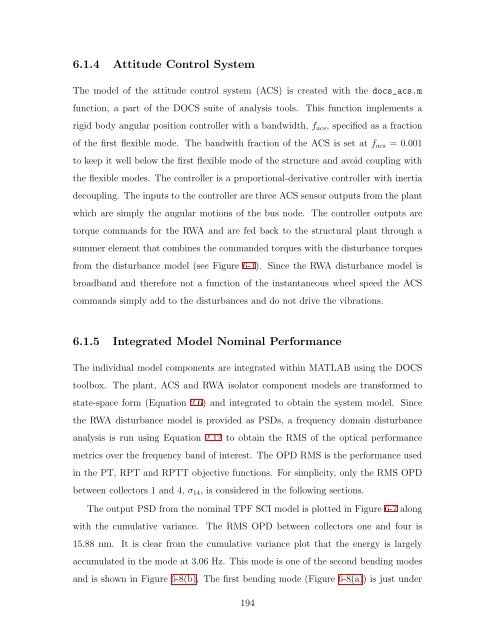Chapter 5 Robust Performance Tailoring with Tuning - SSL - MIT
Chapter 5 Robust Performance Tailoring with Tuning - SSL - MIT
Chapter 5 Robust Performance Tailoring with Tuning - SSL - MIT
Create successful ePaper yourself
Turn your PDF publications into a flip-book with our unique Google optimized e-Paper software.
6.1.4 Attitude Control System<br />
The model of the attitude control system (ACS) is created <strong>with</strong> the docs_acs.m<br />
function, a part of the DOCS suite of analysis tools. This function implements a<br />
rigid body angular position controller <strong>with</strong> a bandwidth, facs, specified as a fraction<br />
of the first flexible mode. The band<strong>with</strong> fraction of the ACS is set at facs =0.001<br />
to keep it well below the first flexible mode of the structure and avoid coupling <strong>with</strong><br />
the flexible modes. The controller is a proportional-derivative controller <strong>with</strong> inertia<br />
decoupling. The inputs to the controller are three ACS sensor outputs from the plant<br />
which are simply the angular motions of the bus node. The controller outputs are<br />
torque commands for the RWA and are fed back to the structural plant through a<br />
summer element that combines the commanded torques <strong>with</strong> the disturbance torques<br />
from the disturbance model (see Figure 6-1). Since the RWA disturbance model is<br />
broadband and therefore not a function of the instantaneous wheel speed the ACS<br />
commands simply add to the disturbances and do not drive the vibrations.<br />
6.1.5 Integrated Model Nominal <strong>Performance</strong><br />
The individual model components are integrated <strong>with</strong>in MATLAB using the DOCS<br />
toolbox. The plant, ACS and RWA isolator component models are transformed to<br />
state-space form (Equation 2.6) and integrated to obtain the system model. Since<br />
the RWA disturbance model is provided as PSDs, a frequency domain disturbance<br />
analysis is run using Equation 2.12 to obtain the RMS of the optical performance<br />
metrics over the frequency band of interest. The OPD RMS is the performance used<br />
in the PT, RPT and RPTT objective functions. For simplicity, only the RMS OPD<br />
between collectors 1 and 4, σ14, is considered in the following sections.<br />
The output PSD from the nominal TPF SCI model is plotted in Figure 6-7 along<br />
<strong>with</strong> the cumulative variance. The RMS OPD between collectors one and four is<br />
15.88 nm. It is clear from the cumulative variance plot that the energy is largely<br />
accumulated in the mode at 3.06 Hz. This mode is one of the second bending modes<br />
and is shown in Figure 6-8(b). The first bending mode (Figure 6-8(a)) is just under<br />
194







